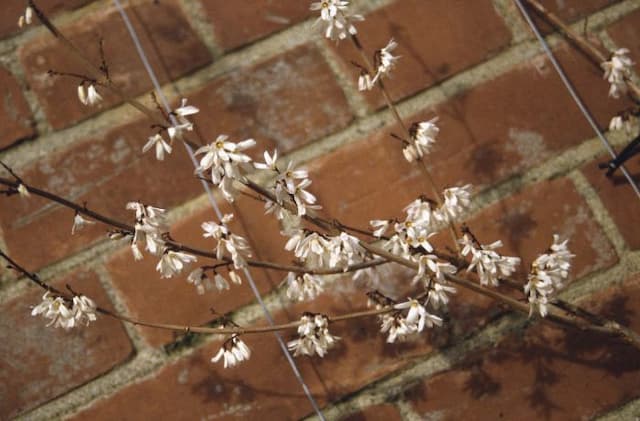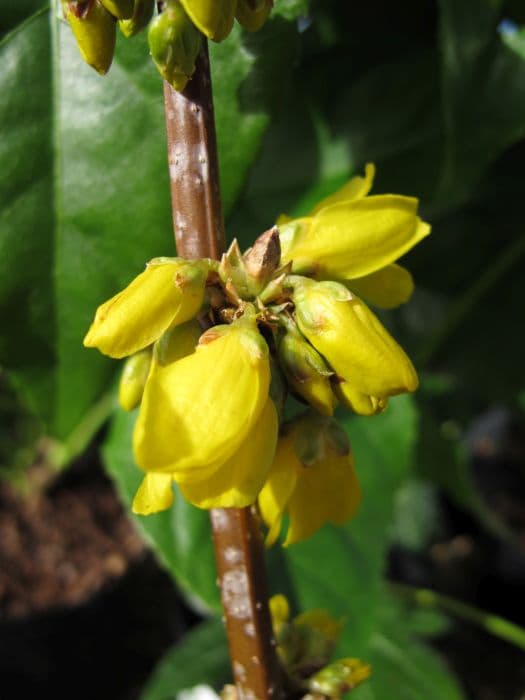Narrow-leaved mock privet Phillyrea angustifolia

ABOUT
P. angustifolia is a compact evergreen shrub to 3m tall, with narrow, dark green leaves to 6cm long, and small clusters of fragrant off-white flowers in the leaf axils in late spring and early summer
About this plant
 Names
NamesFamily
Oleaceae
Synonyms
Narrow-Leaf Phillyrea, Narrow-Leaved Mock Privet
Common names
Phillyrea latifolia var. angustifolia, Phillyrea angustifolia var. rosmarinifolia, Ligustrum angustifolium, Olea angustifolia.
 Characteristics
CharacteristicsLife cycle
Perennials
Foliage type
Evergreen
Color of leaves
Green
Flower color
White
Height
10 feet (3 meters)
Spread
10 feet (3 meters)
Plant type
Shrub
Hardiness zones
7
Native area
Mediterranean
Benefits
 General Benefits
General Benefits- Low Maintenance: Phillyrea angustifolia, commonly known as narrow-leaf mock privet, is known for its low maintenance requirements once established, needing minimal pruning and care.
- Drought Tolerance: It is drought-resistant, making it suitable for xeriscaping and arid environments where water conservation is crucial.
- Erosion Control: Its root system can help stabilize soils and control erosion on slopes or in areas prone to land degradation.
- Habitat for Wildlife: The plant provides habitat and food for birds and insects, contributing to biodiversity in garden spaces or natural areas.
- Ornamental Value: With its dense, evergreen foliage and ability to be shaped through pruning, narrow-leaf mock privet is valued for its ornamental use in gardens, parks, and as hedges.
- Windbreak: It can be used as a windbreak or privacy screen, offering protection against strong winds and creating private green areas.
- Adaptable Growth: Phillyrea angustifolia can grow in a variety of soil types and conditions, which makes it versatile for landscaping in different settings.
- Longevity: It is a long-lived species, providing long-term structure and greenery to the landscape without the need for frequent replacement.
 Medical Properties
Medical Properties- This plant is not used for medical purposes.
 Air-purifying Qualities
Air-purifying QualitiesThis plant is not specifically known for air purifying qualities.
 Other Uses
Other Uses- Phillyrea angustifolia, commonly known as Narrow-leaf Phillyrea, can be used in topiary gardens due to its dense foliage and capacity to be trimmed into various shapes.
- In landscape gardening, Narrow-leaf Phillyrea is often planted as a hedge or screen plant, providing privacy and shelter from wind.
- The wood of Narrow-leaf Phillyrea, being hard and dense, is sometimes used for making small utensils or turned objects like knobs or handles.
- This plant is valued for its ornamental berries which can be used in floral arrangements and decorative wreaths.
- Narrow-leaf Phillyrea's tolerance to coastal conditions makes it a suitable choice for seaside gardens, providing greenery in challenging environments.
- Its ability to grow in shaded areas allows Narrow-leaf Phillyrea to be used effectively in woodland gardens, contributing to the understory vegetation.
- Narrow-leaf Phillyrea can serve as a host plant for certain species of butterflies, supporting local biodiversity.
- Its evergreen leaves can provide year-round cover and nesting sites for small birds and other wildlife.
- Due to its slow-growing nature, Narrow-leaf Phillyrea is sometimes employed as a bonsai, offering a Mediterranean aesthetic to the art form.
- The tree's resistance to air pollution makes it a suitable choice for urban plantings in parks and along streets.
Interesting Facts
 Feng Shui
Feng ShuiThe Phillyrea angustifolia, commonly known as the narrow-leaf mock privet, is not used in Feng Shui practice.
 Zodiac Sign Compitability
Zodiac Sign CompitabilityThe narrow-leaf mock privet is not used in astrology practice.
 Plant Symbolism
Plant Symbolism- Resilience: Phillyrea angustifolia, also known as the green olive tree, is an evergreen shrub typical for its hardiness in rocky and arid soils, symbolizing persistence and the ability to thrive in challenging conditions.
- Longevity: Given its potential to live for many years, this plant represents endurance over time, symbolizing long life and timelessness.
- Protection: With its dense foliage, the green olive tree is often used in hedges, offering a natural barrier, which symbolizes safety and defense.
 Water
WaterFor the Sweet Olive or Oleaster, it's important to establish a consistent watering routine. Water this plant deeply once a week, providing about 1 to 1.5 gallons of water each time to ensure the soil is moist, but not waterlogged. During hot, dry spells, increase the frequency to twice a week. Ensure the plant has well-draining soil to prevent root rot. Cut back on watering to once every two weeks during the cooler months when the plant's water requirements decrease.
 Light
LightSweet Olive thrives best in full to partial sunlight. It should be planted in a spot where it can receive at least four to six hours of direct sunlight daily. Too much shade may result in less vigorous growth and fewer flowers. The ideal location would receive morning sun and afternoon shade, particularly in hotter climates, to protect it from the scorching midday sun.
 Temperature
TemperatureThe ideal temperature range for Sweet Olive is between 50°F and 80°F. It can survive minimum temperatures down to around 10°F; however, prolonged exposure to temperatures below 20°F may damage the plant. Sweet Olive prefers a moderate climate and can be damaged by extreme heat, so it should be situated in a location where it can avoid the full effect of the afternoon sun in summer.
 Pruning
PruningPruning Sweet Olive is mainly for shaping and promoting a dense growth habit. It is best to prune in late winter or early spring before new growth begins. Occasional thinning removes old or dead branches and helps light reach the interior of the shrub, which encourages healthy growth. The plant can also be pruned to maintain a specific size or shape, but heavy pruning should be avoided to preserve the natural form of the shrub.
 Cleaning
CleaningAs needed
 Soil
SoilThe narrow-leaved mock privet thrives in well-drained, fertile soil with a neutral to slightly alkaline pH, around 7.0 to 8.0. A mix of loam, sand, and compost with some organic matter provides the best growing conditions for this evergreen shrub.
 Repotting
RepottingNarrow-leaved mock privet is typically slow-growing and does not need frequent repotting; it can be done every 2-3 years or when the plant outgrows its container.
 Humidity & Misting
Humidity & MistingNarrow-leaved mock privet prefers moderate to low humidity levels and can tolerate the dry air of typical indoor environments without special humidity requirements.
 Suitable locations
Suitable locationsIndoor
Place in bright light, limit water, and ensure good airflow.
Outdoor
Plant in well-drained soil, full sun to part shade.
Hardiness zone
7-10 USDA
 Life cycle
Life cycleNarrow-leaf mock privet (Phillyrea angustifolia) begins its life cycle as a seed, usually dispersed by birds that consume the fruit and excrete the seeds. Upon germination, which requires well-drained soil and partial to full sun, the seedling develops into a small shrub. As it matures, the plant experiences vegetative growth, producing narrow, leathery leaves and a dense, rounded to bushy form. Flowering occurs in spring, with small, fragrant, creamy-white flowers attracting a variety of pollinators. After pollination, these flowers develop into small purple-black drupes (fruits) by late summer to autumn, which are then consumed by birds, completing the cycle of seed dispersal. Phillyrea angustifolia has a slow to moderate growth rate and can live for many years, developing into a dense, evergreen shrub reaching up to 2-3 meters in height.
 Propogation
PropogationPropogation time
Spring-early summer
Propogation: The most popular method of propagation for Phillyrea angustifolia, commonly known as Narrow-leaf mock privet, is through semi-hardwood cuttings. This typically occurs in late summer, when new growth has matured enough to be slightly firm but still flexible. A cutting of about 4 to 6 inches (10 to 15 centimeters) is taken, with several leaves left at the top and the lower leaves removed. The base of the cutting is then dipped in rooting hormone to promote root development and planted in a well-draining potting mix. The cutting should then be kept in a warm, humid environment with indirect sunlight, ensuring consistent moisture but avoiding waterlogged conditions. Roots usually develop within weeks, after which the cutting can be gradually acclimated to outdoor conditions before planting in its final location.








